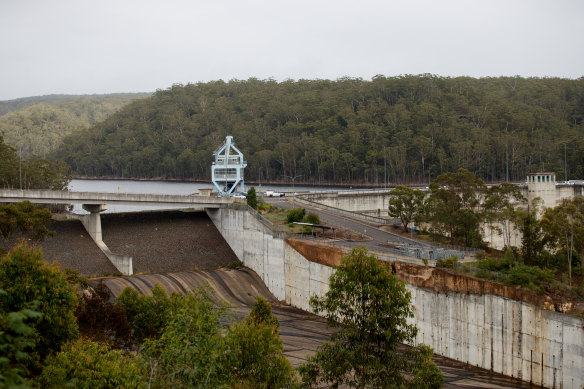The NSW Labor government will rethink its water security policy – including doubling the capacity of Sydney’s desalination plant and keeping Warragamba Dam below capacity – to guarantee the city’s drinking water supply while mitigating flood risk.
Premier Chris Minns said the state government was considering a range of options after the Hawkesbury-Nepean region was inundated with floodwaters during the weekend’s torrential rainstorms, which saw the city’s main dam spill.
One option would be to ensure Warragamba does not exceed 80 per cent of its capacity.

Much of Sydney’s tap water comes from Warragamba Dam.Credit: Nikki Short
However, Minns warned long-term solutions for flood mitigation would take time and considerable investment and the only immediate answer was to ban all new housing developments on flood-prone land.
“I want to make it clear that we’re looking at all potential changes, including dropping the maximum allowable level of Warragamba,” Minns said on Tuesday.
“However, I can’t consider doing that unless I supplement Sydney’s drinking water supply in the meantime. So that’s not going to give us an immediate relief. It’s going to take a bit of time.”
He said Planning Minister Paul Scully had banned tract housing in areas at risk of flooding.
“The measures the government is deploying immediately, however, is restricting housing on the floodplain, we don’t want to make a bad decision even worse,” Minns said.
Minns first floated the idea of lowering Warragamba’s maximum limit and supplementing it with a desalination plant in 2018 when he was the shadow water minister.
“The very least the government should do is look at the viability of lowering the maximum limit on Warragamba and supplement it with the ‘mothballed’ desalination plant,” Minns said at the time.
The Coalition first pledged to raise the Warragamba Dam wall in 2016 under then-premier Mike Baird. At the time, the cost of the project was about $700 million but Minns said it had now ballooned to at least $2 billion.
NSW Labor did not support the raising of the wall at the March election, but Minns said it was not only about the considerable upfront cost, because that would also exist for other projects.
“If we were to boost Sydney’s water supply with infrastructure in western Sydney [that] would be a big capital upfront expense, if we were to double the size of the desalination plant, that’s a big upfront capital expense,” Minns said.
The Liberal mayor of Hawkesbury council, Sarah McMahon, has been highly critical of Minns, accusing the premier of ignoring the region, which had been flooded seven times in four years.
“Mr Minns is missing,” McMahon said on Tuesday.
Successive state governments have allowed development on the Hawkesbury-Nepean Valley, despite the region having one of the greatest flood risks in NSW, placing thousands of home owners at risk of inundation.
The independent inquiry into the catastrophic 2022 NSW floods said the “single largest driver” of risk in the Hawkesbury-Nepean Valley was ongoing development on the floodplain.
McMahon said Hawkesbury City Council did not approve housing where floodwaters could exceed 17.3 metres AHD (Australian Height Datum, the height above mean sea level).
However, she said the region was in desperate need of road and levee upgrades.
She criticised the Labor government for failing to deliver on its election promise to invest more than $200 million into a Western Sydney Floods Resilience plan for evacuation roads, levees and communications infrastructure.
Minns’ office was contacted for comment.
Most Viewed in Politics
https://news.google.com/rss/articles/CBMidGh0dHBzOi8vd3d3LnNtaC5jb20uYXUvcG9saXRpY3MvbnN3L3RoZS1wbGFuLXRvLXNhdmUtb3VyLWRyaW5raW5nLXdhdGVyLXdpdGhvdXQtZmxvb2Rpbmctc3lkbmV5LTIwMjQwNDA5LXA1ZmlkYS5odG1s0gEA?oc=5
2024-04-09 02:36:27Z
CBMidGh0dHBzOi8vd3d3LnNtaC5jb20uYXUvcG9saXRpY3MvbnN3L3RoZS1wbGFuLXRvLXNhdmUtb3VyLWRyaW5raW5nLXdhdGVyLXdpdGhvdXQtZmxvb2Rpbmctc3lkbmV5LTIwMjQwNDA5LXA1ZmlkYS5odG1s0gEA
Bagikan Berita Ini














0 Response to "The plan to save our drinking water without flooding Sydney - Sydney Morning Herald"
Post a Comment